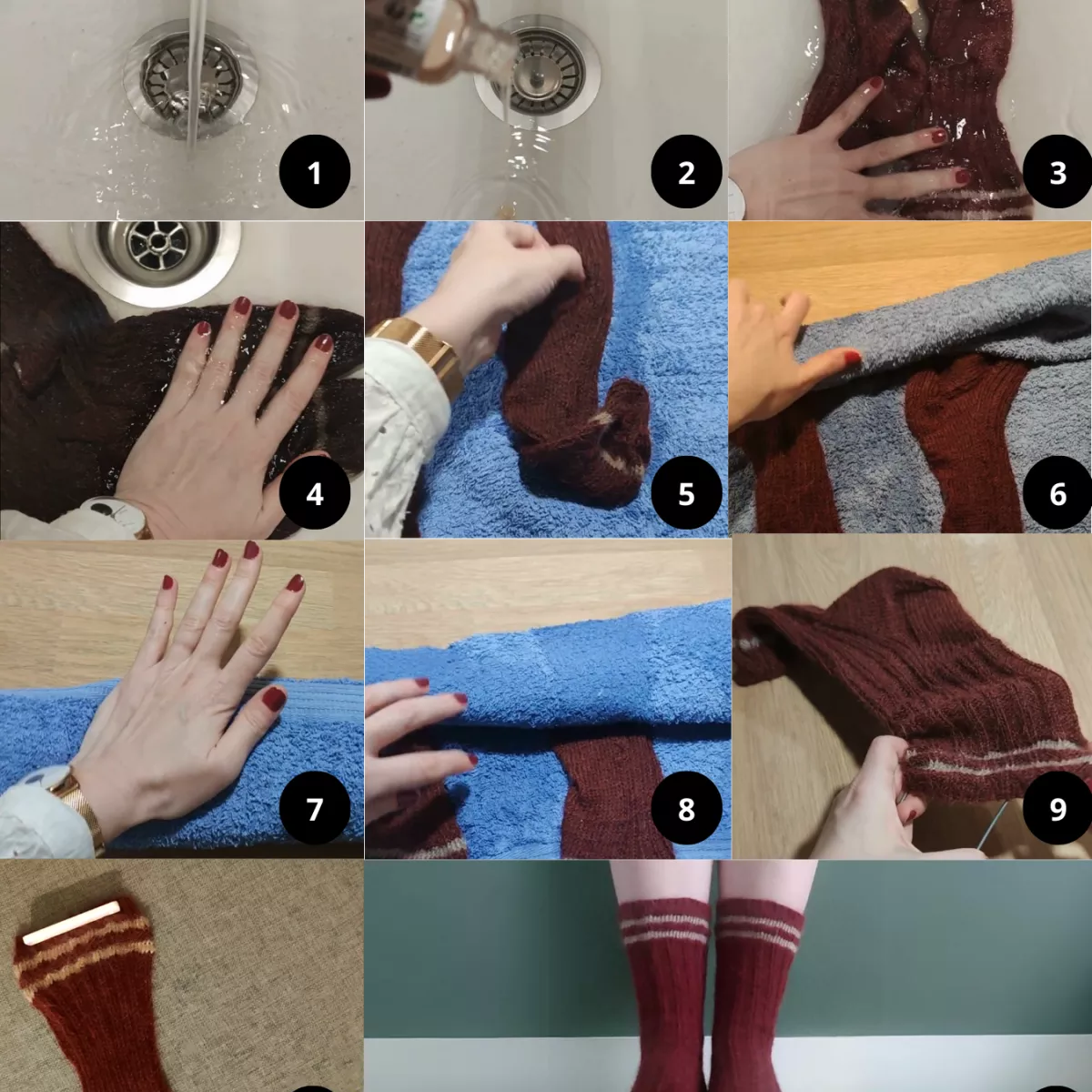What's That?
What is blocking?
It's a method that involves soaking your knitting in water and then letting it dry. But you might ask, why call it blocking and not just washing?
The reason is that, in fact, we let the project dry flat, making sure that all parts are in the correct dimensions. To achieve this, we secure them with pins, combs, or a specific support to ensure they don't move.
The Point
If this method is widely used by knitters, it's because it offers several advantages:
- As the name suggests, it primarily serves to block the work. This prevents it from stretching over time and losing its shape, especially with soft fibers like alpaca.
- It also allows for rectifying errors, providing more consistency to the work, ensuring a straight drape of the stitches.
- Additionally, it helps eliminate spinning grease or any potential unpleasant odors.
- It also aids in breaking the stiffness of fibers and adding flexibility to the material and might help gaining a few centimeters in length or width. .
However, there are also some less positive aspects:
- This step is often overlooked or considered tedious because it requires time, and one must wait for the complete drying before being able to wear the finished project.
- It's a meticulous task, especially in checking the dimensions, and if not done carefully, the work may come out deformed.
- In the case of soft materials or oversized designs, blocking tends to cause some stretching. If you've knitted too loosely, there's a risk of an overly saggy appearance. It's advisable to knit smaller in such cases to anticipate this stretching.
While blocking is not mandatory, it's essential to keep in mind that without it, your work may tend to shift or change shape over time.
Sock Blocking
Blocking socks is a bit particular compared to other knitting patterns.
Indeed, it requires both socks to be strictly the same size and perfectly tailored to your morphology or standardized dimensions.
To facilitate this process, special sock blockers are available in stores. It's worth noting that using them is not mandatory, and you can work with pins or combs, as you would for any other project. However, if you're a handmade sock enthusiast, sock blockers come in handy as they streamline the blocking process and accelerate drying.
If you're interested in sock blockers, know that you don't necessarily have to buy them. It's quite simple to make your own using wire or old metal hangers for #recycling and #reuse. In the "Tools" section of this website, you'll find a tutorial on how to make your own pair or more!
The Method
For your information, if you're looking for something more visual, the instructions below are also available in a YouTube video on my channel here: https://youtu.be/Z_Gg70GExFE
But if you prefer written instructions, here are the detailed steps to block a pair of socks:
- Prepare a warm water bath in a sink, basin, or a large enough container to accommodate your project.
- Add a bit of special wool detergent. It's not mandatory, as it's the water that matters, but it can help remove certain odors.
- Add the socks and let them soak for a maximum of 15 minutes. Some recommend a bath between 15 and 30 minutes, but personally, I work only with natural fibers, which are more delicate, and I prefer to avoid soaking them too much to prevent damage. The essential thing is that your entire project is immersed in the water.
- Drain the water and press on the socks to remove excess water with the flat of your hand. Never twist them as it breaks the fibers!
- Lay the socks flat on a towel or an absorbent fabric.
- Roll the towel like a crepe!
- Press hard to remove excess water. You can also step on it, but still, don't twist.
- Unroll the towel.
- Option 1: Place the sock on a special blocker (see tutorial). Option 2: Use combs or blocking pins. Don't forget to check that the dimensions conform to your measurements or the pattern standards for this option. Adjust the placement of the combs/pins if necessary.
- Wait for everything to dry. The advantage with my blockers is that I added a small hook to hang them on the radiator, and the socks are ready in one night!
And there you have it, a lovely pair of blocked socks, ready to embark on all the adventures at your feet!
Don't forget to tag me on Instagram, Facebook, or TikTok with the hashtags #terrifiknits and #socksblocking once you're done! I can't wait to see the beauties you'll block with this tutorial!
What You'll Need:
- Warm water
- Some wool detergent (optional)
- Sock blockers (how to available in the "Tools" section) or blocking combs or pins.




There is no comment yet.
Add a comment